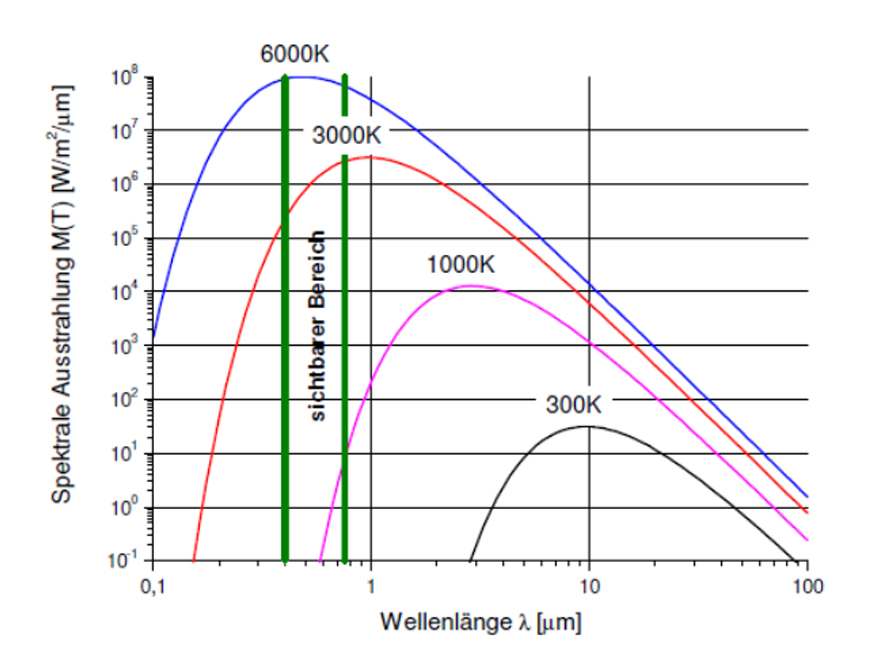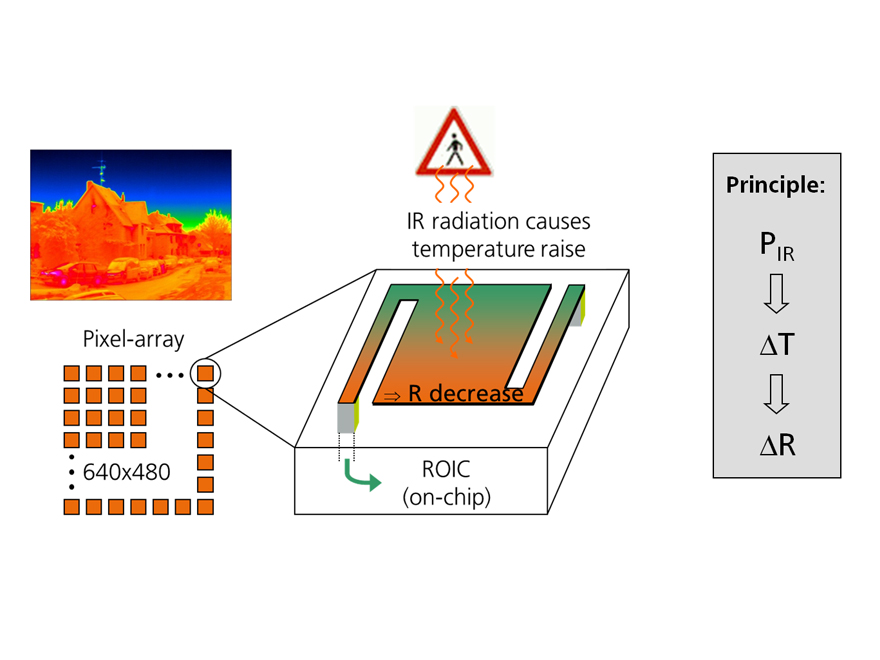

How do microbolometers function as sensor elements of an uncooled IR imager?
Every object with a temperature above absolute zero emits electromagnetic radiation caused by the movement of its atoms. At room temperature in the range of 300 K the majority of emitted radiation power is in a wavelength range between 8 μm and 14 μm. This is the so-called far-infrared (FIR) spectral range that is sometimes called LWIR range (long-wave infrared range) as well. Passive, uncooled thermal imaging cameras use this effect for image generation. In this process they don’t need an active light source, because the emitted radiation of the object is detected instead.
The maximum emitted radiation power varies according to the temperature of the object. This effect is called Wien’s displacement law and is the reason why FIR radiation is also called thermal radiation. For the amount of emitted radiation power within a specific wavelength range between λ1 and λ2 for an object of the temperature T the following Planck function applies:
Here, h is Planck’s universal constant, k the Boltzmann’s constant and c the vacuum speed of light.
Apart from the temperature, the emitted radiation power of an object is also defined by its emissivity ɛ. The emissivity is a factor dependent on material und in general the function of a wavelength. An object with an emissivity independent of wavelength of 1 is called a black body. A black body emits the maximum amount of radiation possible to a given temperature. Besides the emissivity of an object, its reflectivity ρ and its transmissivity τ have to be considered as well, for which the reason of energy conservation the link ɛ+ τ +ρ=1 is applied.
The emitted radiation can be detected using an uncooled IR imager which consists of three main components:
- Microbolometers as IR-sensitive sensor elements
- Vacuum-housing with IR window for reduction of thermal losses caused by gas convection
- Readout circuit (ROIC= readout integrated circuit) for electronic readout of microbolometers and conversion into an image format
The microbolometer as a sensor element of an uncooled IR imager works according to the thermal principle. Using a good microbolometer, the incident IR radiation is absorbed by a sensor membrane and, because of its good thermal insulation, converted according to the incident energy into a temperature increase. The sensor membrane consists of a material that reacts to temperature changes with a great change of its electrical resistance. This change in resistance is being converted into a video signal. If the microbolometers are arranged in a two-dimensional array, for example 320x240 or 640x480, an image of the temperature distribution in a scene can be determined using an uncooled IR imager.
Differences between cooled and uncooled IR imagers
Apart from the uncooled IR imagers that work according to the thermal principle, there are also cooled IR imagers. These cooled IR imagers work according to the photonic principle in which impinging photons generate electron-hole pairs. Due to the low energy of LWIR radiation (e.g. E(l = 10 µm) = 0.124 eV) a material with a corresponding small band gap Eg has to be chosen for the photonic sensors, for example Hg1-xCdxTe (Eg = 0.155 eV für x = 0.2) or InSb (Eg = 0.17 eV). For the reduction of the dark current rate generated thermally by electron-hole pairs, these types of IR imagers have to be cooled. Typically, Stirling coolers are used that cool the infrared sensors down to, for example, 77 K. Because of the detector principle they reach a good thermal resolution, but due to the specific detector material and the needed cooling they are very expensive and almost exclusively used for military applications.
NETD value
The most important characteristic value of uncooled IR imagers is the NETD value (noise equivalent temperature difference) that describes the temperature resolution. The NETD value is typically indicated in the unit mK and describes the feature of the sensor to resolve the smallest temperature differences in a scene. This way, more performant infrared sensors are characterized by smaller NETD values. Good uncooled IR imagers can reach NETD values of less than 60 mK, but for many applications temperature resolutions aren’t necessary and sensors with bigger NETD values can be used. The NETD value is often limited by the temporal noise behavior.